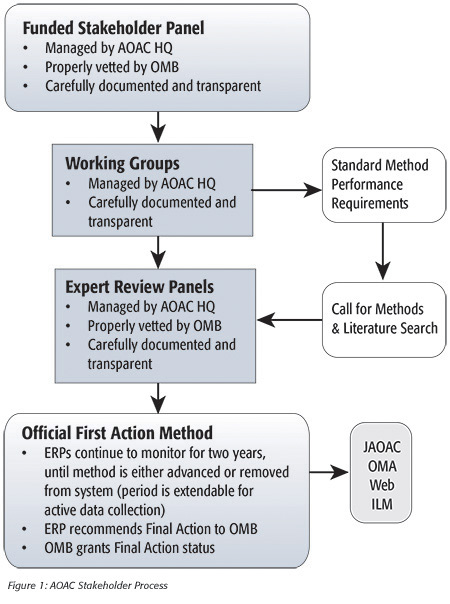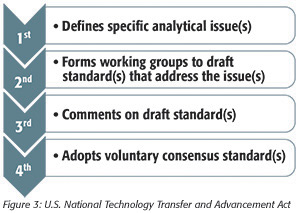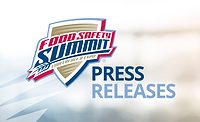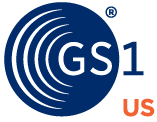Food safety has been identified as a top priority by AOAC International, and as an area of investment for its future, with the goal of strengthening the association’s value as a leader in standards development and a provider of analytical methods.
After spending the last couple of years successfully focused on issues or topics of interest to stakeholders related to food or strategic growth of the food industry, AOAC recently shifted its focus to food safety. AOAC board members met with Global Food Safety Initiative (GFSI) officers earlier this year in Anaheim, CA, and presented how a new strategic course has been set for the association, which has begun identifying and prioritizing possible issues within food safety to help develop solutions to global issues by establishing voluntary consensus standards.
On February 25, 2014, during the GFSI meeting, AOAC board members Darryl Sullivan (Covance Laboratories) and David Acheson (The Acheson Group) advocated AOAC’s standards development activities. They explained the process and pointed to the association’s successes to date in setting much needed standards for the food industry. The initiative has resulted in standard method performance requirements (SMPRs)—voluntary, consensus standards, developed by stakeholders, that prescribe minimum analytical performance requirements for classes of analytical methods—for antioxidant activity, flavonols, vitamins A, D, E and K, heavy metals and Saint John’s wort, and three AOAC Official Methods of AnalysisSM each for antioxidants and flavonols.
“This output comes off of other huge AOAC successes,” said Sullivan. He gave examples of AOAC initiatives with the soft drink and infant formula industries. This latter project accounts for the approval of more than 20 SMPRs and 32 AOAC First Action Official Methods since 2011. (A number of these infant formula methods are currently being reviewed by ISO/IDF under a cooperative agreement, whereby these organizations will work in parallel on standards and methods.)
Sullivan continued, “AOAC’s initiatives have brought together forward-thinking participants and industry thought leaders to examine and come to consensus on the most important issues impacting the food industry. Strategically shifting the direction to food safety helps ensure that the association continues to remain relevant.” AOAC provides a forum for its Organizational Affiliate members, which represent some of the largest multinational food companies, leading test kit and instrument manufacturers, contract research organizations and stakeholders to have a voice in driving activities and collaborate and solve issues affecting the industry as a whole.
Food safety continues to be a serious concern for consumers. Consumer confidence needs to be strengthened and maintained as the food supply chain is made safer. Acheson added that AOAC can help solve analytical challenges faced by GFSI and the food industry by bringing stakeholders together to reach consensus on much-needed food safety standards.
GFSI, as previously reported in Food Safety Magazine, is a business-driven initiative to ensure confidence in the delivery of safe food to consumers worldwide. It was launched in 2000 following a number of food safety crises when consumer confidence was at an all-time low; now experts from all over the world are collaborating in numerous GFSI Technical Working Groups to tackle current food safety issues defined by its stakeholders. Key activities within GFSI include the definition of food safety requirements for food safety schemes through a benchmarking process. This process leads to recognition of existing food safety schemes and drives growing confidence, acceptance and implementation of third-party certification along the entire food supply chain.
AOAC’s Standards Development and Methods Approval Process
During the February 2014 GFSI meeting, with an eye toward developing an AOAC-GFSI collaborative effort on specific food safety issues, Sullivan and Acheson explained the fundamentals of the AOAC process and how AOAC partners with industry to lead the effort to develop voluntary consensus standards. In the food industry, there is a need for internationally accepted, fit-for-purpose testing methods. Different methods are used around the world, leading to varying test results that don’t provide confidence. “AOAC’s industry partners have expressed needs for consensus-based SMPRs and a process that give them a strategic direction and let them voice their needs for priorities in food safety,” said Sullivan. AOAC’s stakeholder food panel is driven by major multinational food companies who are AOAC Organizational Affiliate members.
So, how does the AOAC stakeholder process work?
Advisory Panel
 The first step in developing voluntary consensus standards begins with establishing an advisory panel comprising key leaders in the community (Figure 1). This panel identifies key stakeholders and subject matter experts, frames the issues, determines analytes and sets priorities for the stakeholder panel. The advisory panel identifies a comprehensive list of potential stakeholders for the standards-setting activities. These potential stakeholders may be officials from foreign and domestic regulatory agencies, global standards bodies, academia, contract research organizations and any others who have an interest.
The first step in developing voluntary consensus standards begins with establishing an advisory panel comprising key leaders in the community (Figure 1). This panel identifies key stakeholders and subject matter experts, frames the issues, determines analytes and sets priorities for the stakeholder panel. The advisory panel identifies a comprehensive list of potential stakeholders for the standards-setting activities. These potential stakeholders may be officials from foreign and domestic regulatory agencies, global standards bodies, academia, contract research organizations and any others who have an interest.
Stakeholder Panel
 This panel (Figure 2) comprises anyone with a material interest. Participants include, but are not limited to, product manufacturers, analyte/method subject matter experts, technology providers, method experts, government and regulatory agencies, contract research organizations, reference materials developers, manufacturers, method end-users, academics, nongovernmental organizations, AOAC volunteers and others as identified. AOAC ensures a balanced group of voting stakeholders. Stakeholders engage and deliberate on the priority objectives as determined by the advisory panel. A stakeholder panel accomplishes its work via working groups to draft standards.
This panel (Figure 2) comprises anyone with a material interest. Participants include, but are not limited to, product manufacturers, analyte/method subject matter experts, technology providers, method experts, government and regulatory agencies, contract research organizations, reference materials developers, manufacturers, method end-users, academics, nongovernmental organizations, AOAC volunteers and others as identified. AOAC ensures a balanced group of voting stakeholders. Stakeholders engage and deliberate on the priority objectives as determined by the advisory panel. A stakeholder panel accomplishes its work via working groups to draft standards.
 Stakeholder panels deliberate and reach consensus on standards. All stakeholders share and contribute to the discussions; however, consensus of the stakeholders is demonstrated via voting conducted with a vetted, balanced group of stakeholders in which all perspectives are represented. To ensure stakeholder panel meetings include a process in which all stakeholders are afforded due process, the latest edition of Robert’s Rules of Order serves as the parliamentary procedures framework facilitating stakeholder panel deliberations. AOAC follows its standard governance process, and the activities are conducted in accordance with U.S. OMB Circular A-119 and the U.S. National Technology Transfer and Advancement Act (Figure 3; Public Law 104-113), so that the resulting performance requirements will be considered as voluntary consensus standards.
Stakeholder panels deliberate and reach consensus on standards. All stakeholders share and contribute to the discussions; however, consensus of the stakeholders is demonstrated via voting conducted with a vetted, balanced group of stakeholders in which all perspectives are represented. To ensure stakeholder panel meetings include a process in which all stakeholders are afforded due process, the latest edition of Robert’s Rules of Order serves as the parliamentary procedures framework facilitating stakeholder panel deliberations. AOAC follows its standard governance process, and the activities are conducted in accordance with U.S. OMB Circular A-119 and the U.S. National Technology Transfer and Advancement Act (Figure 3; Public Law 104-113), so that the resulting performance requirements will be considered as voluntary consensus standards.
Working Groups
Working groups provide scientific credibility by establishing draft SMPRs. The working group is the problem-solving group to identify the complexity of each analyte and provide solutions as issues arise. Working groups consider fitness for purpose, matrices, analytes, analytical ranges, stability, interferences/specificity, sample extraction, limits of detection and types of instrumentation (screening or confirmatory). Working groups reconcile public comments received on draft standards and make recommendations on standards to the stakeholder panel. These groups include global government, industry and academia representatives.
Expert Review Panels
Expert review panels (ERPs) provide stakeholders with an expert resource to evaluate analytical solutions to identified needs and concerns. ERPs are responsible for the careful scrutiny and systematic review of methods and the adoption of methods as AOAC First Action Official Methods. ERPs are composed of stakeholders whose collective expertise is balanced and vetted for conflict of interest.
As appointed AOAC volunteers, ERP members apply their collective expertise and use the standards developed by the stakeholders to evaluate submitted methods. ERPs carefully scrutinize methods and data available in an unbiased, science-based peer review and evaluation against approved SMPRs (i.e., adopted by the stakeholder panel). ERP voting on methods for Official Methods status is conducted in accordance with AOAC policy.
Initial Priorities for Food Safety
Already, AOAC’s Organizational Affiliate members have “begun brainstorming potential food safety/adulteration/food fraud issues, prioritizing needs and identifying gaps and available tools,” Sullivan said. A variety of issues were identified, and, after careful consideration, the group narrowed down the list to the following initial priorities:
• Heavy metals speciation
• Food fraud and adulteration
• Meat species
It was agreed that microbiology, pesticides, mycotoxins and DNA for quality assurance of food materials are topics to be further examined at AOAC’s upcoming annual meeting.
AOAC continues to engage industry to set food safety priorities. The initial list of priorities, as identified by the stakeholder panel and reviewed by an advisory panel, will be introduced for standards development activities as initial food safety priorities on September 7, 2014, in conjunction with the AOAC Annual Meeting in Boca Raton, FL.
The food panel meeting will kick off with a panel discussion featuring three experts on food safety issues. With more than 30 years of medical and food safety research and experience, David Acheson will provide a leading perspective on the global food safety issue. Robert Brackett, Institute for Food Safety and Health, will identify and discuss areas of concern that AOAC may be interested in pursuing, while Samuel Godefroy, Health Canada, will give an international perspective as well as focus on trade issues within the industry.
For more information on the AOAC food safety initiative, contact Dawn Frazier, executive for scientific business development, at dfrazier@aoac.org or visit www.aoac.org.
For more information on GFSI, visit www.mygfsi.com/.
 Darryl Sullivan is the director of scientific and regulatory affairs for the nutrition chemistry and food safety division at Covance Laboratories. He received his B.Sc. from the University of Wisconsin, Madison, and has more than 30 years of experience in laboratory testing of food and dietary supplements. He is a member of the Editorial Advisory Board of Food Safety Magazine.
Darryl Sullivan is the director of scientific and regulatory affairs for the nutrition chemistry and food safety division at Covance Laboratories. He received his B.Sc. from the University of Wisconsin, Madison, and has more than 30 years of experience in laboratory testing of food and dietary supplements. He is a member of the Editorial Advisory Board of Food Safety Magazine.




